Style
Architect Peter Marino on How He Revamped Tiffany & Co.’s New York Flagship and Turned It Into a 10-Story Art Gallery
The famed architect has filled the Fifth Avenue flagship, dubbed the Landmark, with major works of art.
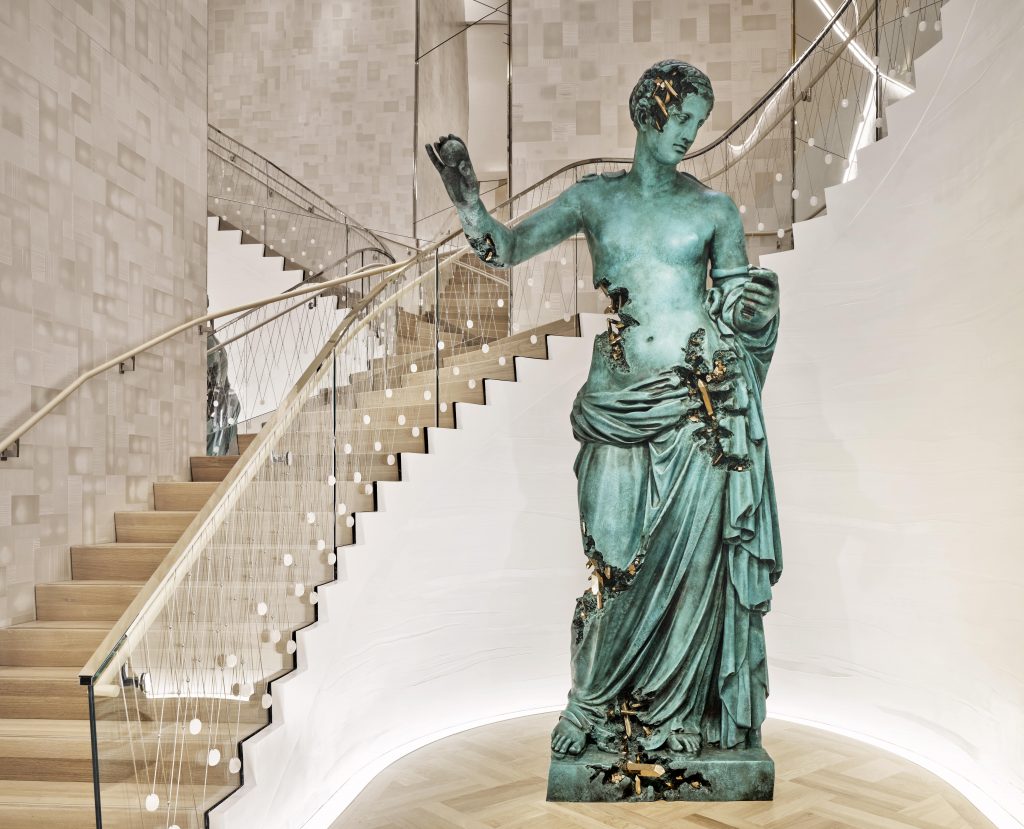
The famed architect has filled the Fifth Avenue flagship, dubbed the Landmark, with major works of art.

William Van Meter

In April, Tiffany & Co. unveiled its newly redesigned New York Fifth Avenue flagship, christened the Landmark. “You kind of had to take the Phoenix out of the ashes,” said the architect Peter Marino, who helmed the revamp. If Marino sounds like he is being overly grandiose with his rebirth metaphor, he’s not. This is much more than a run-of-the-mill visual merchandizing spruce-up, but a complete reimagination—not just of the building, but of the brand. In fact, it redefines what a store can be, blurring the line between retail and gallery space. The Landmark is the most extravagant exemplar in the continued trajectory of making art as synonymous with Tiffany as its patented blue hue.
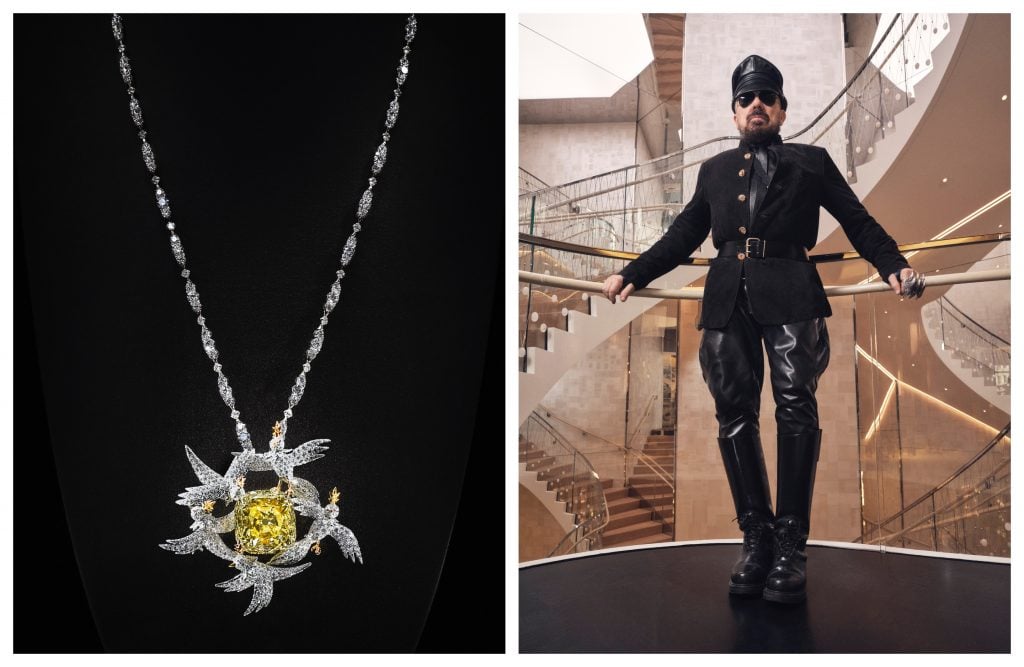
Two icons: the Tiffany Yellow Diamond and Peter Marino. Courtesy of Tiffany & Co.
Is the Landmark an art project itself? Well, it’s certainly not just a jewelry shop. At the very least, it is a 10-level luxury store that doubles as a world-class art gallery. Daniel Arsham’s 12-foot Bronze Eroded Venus of Arles encapsulates the Landmark’s dichotomous ethos. A towering sculpture evoking antiquity, classical beauty, and juxtaposed eras, her body is riddled and pierced with shiny, jagged gold bricks. In fact, it’s the art that supplies the space’s pops of Tiffany blue (as well as the fabulously covetable traffic cones outside).
Marino, who has been an avid collector for over 40 years and has a namesake art foundation in Southampton, New York, served as the Landmark’s art guru and curator. He assembled a staggering selection of sourced and commissioned works. The magnitude of the artists displayed includes Anish Kapoor, Richard Prince, Jeff Koons, Julian Schnabel, and Jenny Holzer.
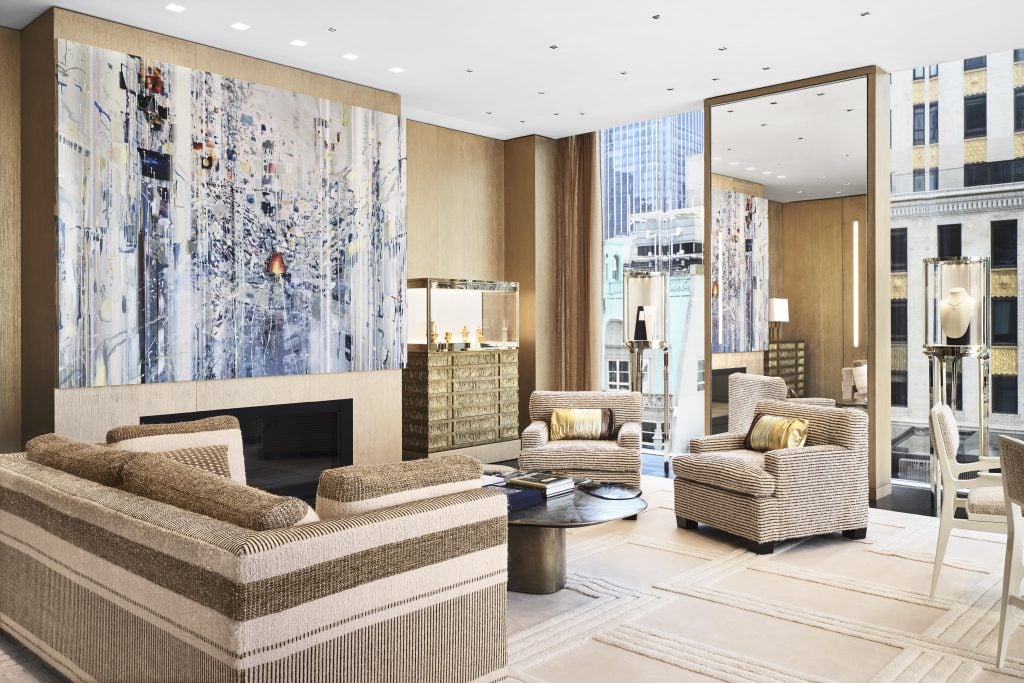
Sarah Sze’s First Time (Half Life) (2023) dominates the exclusive penthouse, the Tiffany Private Club. Courtesy of Tiffany & Co.
The abstract silver glamour of Sarah Sze’s First Time (Half-Life) adorns the exclusive top floor salon, the Tiffany Private Club, which is reserved for VIPs and the highest of rollers. “She’s a super talented artist, and like a lot of them, she’s a friend of mine,” Marino explained. “I was like, look, this is going to be treated with ultimate respect. I brought Sarah in when it was still just a concrete shell. Come and look at where I want you to do something. It’s the most important room in the whole building. It has the view of the park. It’s where the highest sales will be. It’s the closest to heaven, my love! She was an angel and kept saying, ‘You know, I have that Guggenheim show coming up.’ And I was like Guggenheim Schmuggenheim. This will be there for the next 100 years. Guggenheim will be over in four months.”
Tiffany should persuade Marino to moonlight on the sales floor. “But you do have to sell to the artists!” he noted. “I said, just make me an exploding diamond! Lights! She’s an Aquarius and she loves shiny things.”
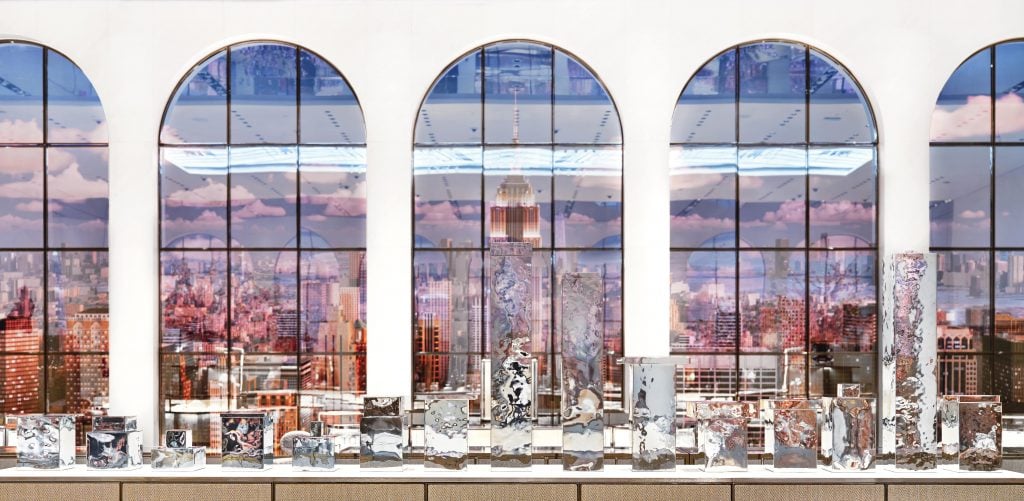
No Vital, untitled (2021–2022). Courtesy of Tiffany & Co.
Upon entrance one is greeted with a row of the Swiss artist Not Vital’s abstract geometric sterling silver sculptural portraits. “I thought they were terribly beautiful, special and weird,” Marino said. “People think it’s the New York skyline. Not at all, lovey! It’s the 15 most famous women who ever wore the Tiffany diamond!”
He added, “You have to make art the focus, jewelry is so small. It can’t be a ring. With these vast rooms, it’s never going to be jewelry. It’s always going to be the art.”
Rashid Johnson previously had an exhibition at Marino’s foundation. “I said, Rashid, I’m not going to put you in a row of handbags,” Marino recalled of their dialogue. “You’ll be the one work of art. Everything else on the wall is incredibly diaphanous, very sexy. I need anything you want to do on the cracked mirror series that I had seen six or seven years before. He was absolutely brilliant to work with.” Johnson’s seven-foot-tall mirrored mosaic depicts an upside-down Tiffany blue figure with tar-like drippings of black wax.
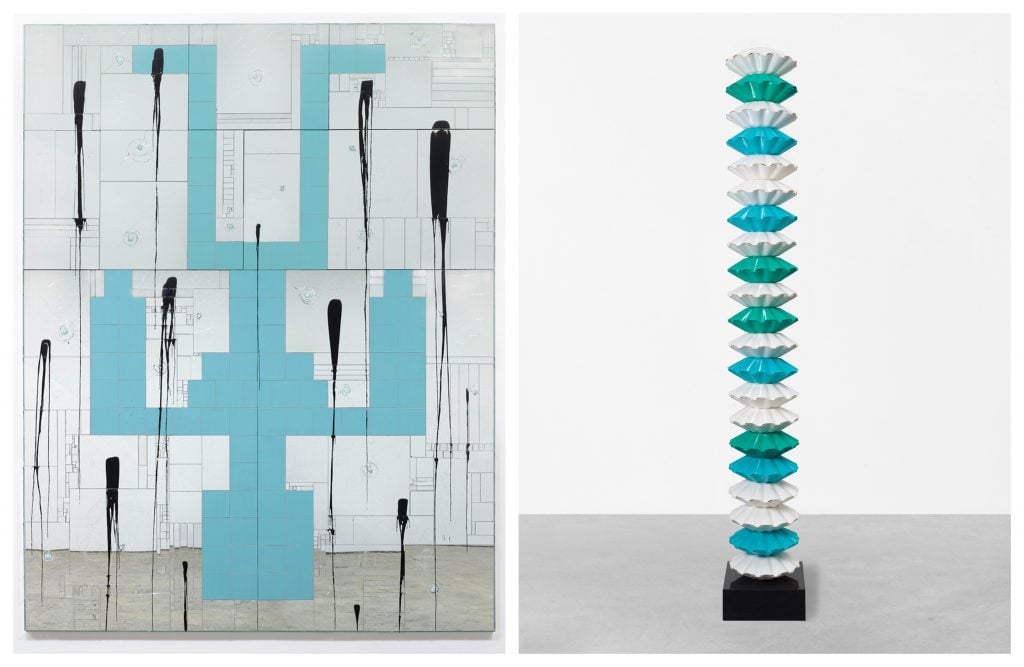
Left: Rashid Johnson, Falling Man (2023). Photo: Stephanie Powell. Right: Gregor Hildebrandt, Blue Leo (2022). Photo: Roman März. Courtesy of Peter Marino Architect.
For Sze, Johnson, and the other commissioned artists such as Vik Muniz and Damien Hirst, the prompt was clear. “I’d like anything that’s iconic Tiffany to you as an artist,” Marino explained. “For Sarah Sze it was the diamond. For Rashid it was the blue.” Anna Weyant took the literal and still-life approach. Her diptych captures a gift box and its contents (a gold Tiffany HardWear necklace). They hang in an intimate private viewing salon.
Tiffany & Co.’s art world reinvention corresponds to the LVMH purchase of the brand, completed in early 2021, and Alexandre Arnault’s ascension to executive vice president. In fact, Arnault commissioned the Arsham Venus. “I’ve been working for the Arnault family since 1994,” Marino said. “Three quarters are commissioned by my own staff, the other quarter by the Arnault family—a really good collaboration.”
Arnault signaled his arrival, and the new Tiffany, with a gauntlet-drop of a statement, the Jay-Z and Beyoncé advertisement in which the uber-power couple posed with of Basquiat’s Equals Pi (1982). The singer also wore the iconic Tiffany Yellow Diamond around her neck. “It was terribly clever,” Marino said of the ad. “In order to turn a very large ship around, you need a lot of power. That painting did it.” The Basquiat, forever intertwined with Tiffany, hangs in front of the ground floor elevators; the legendary necklace is enshrined in a nearby mirrored niche. In a clever move, Marino hung Wade Guyton’s untitled 2022 inkjet painting of a New York Times cover that features the Basquiat advertisement in the Landmark’s library.
The art on view at the Landmark will evolve and change every six months to a year, Marino estimated. “The show will then go to other Tiffany flagships I’m doing around the world,” he explained. “Each of the flagships will have a really powerful painting statement. No more Basquiats because we don’t want to repeat the theme, but the selection of paintings is formidable, and I’m having great fun commissioning them.”
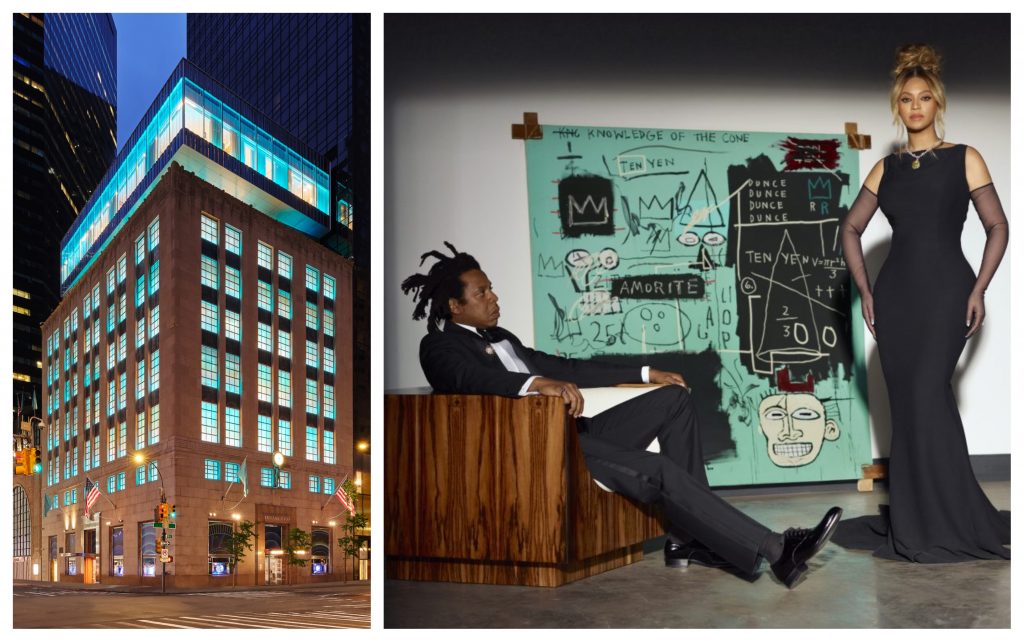
Left: a night view of the Landmark’s exterior. Courtesy of Tiffany & Co. Right: Beyoncé and Jay-Z with Jean-Michel Basquiat’s Equals Pi (1982) for the Tiffany & Co. fall 2021 campaign. Photo: Mason Poole. Courtesy of Tiffany & Co.
But where exactly does the art come from? Is it mostly Arnault or LVMH-owned or sourced from the Peter Marino Foundation. “It’s all of the above, and you don’t need to know where it comes from,” Marino said. “Some of it is a personal loan, some of it is foundation. Much of it belongs to Tiffany’s. But each one has a different story. It’s not all out of one fund.”
The flagship also serves as a museum to the brand itself. Classic store vitrines from its legendary window pioneer Gene Moore are recreated and an Avedon portrait of designer Paloma Picasso surveys her jewelry collection with Tiffany. The experimental creations of Jean Schlumberger are elevated into sculpture behind display cases.
An original Breakfast at Tiffany’s script is behind glass, as is Audrey Hepburn’s Givenchy black dress from the film. Marino hand-painted Keith Haring-like squiggles radiating from portraits of Hepburn in the film that are placed in a mini shrine to the actress where visitors can take selfies. “I wanted almost an Audrey chapel,” said Marino, who faced pushback and had to downsize the chamber. “Already over a million people have done selfies. I said, it’s going to help us sell more than you can imagine. I’m gonna play fucking ‘Moon River’ and make all of you cry. If you go in there and you don’t cry, there’s something wrong with you.”

Damien Hirst’s Apple Blossom wallpaper adorns the Apple Blossom Suite. Courtesy of Tiffany & Co.
It’s a shame that the elevators aren’t slower at the Landmark. On every floor, the elevator vestibule is adorned with a knockout piece. James Turrell’s serenely color-shifting egg-like sculpture on the fourth floor is contrasted with Hans Hartung’s turgid and swirling T 1985 H12 acrylic painting. Damien Hirst’s cheeky (yet gorgeous) display case of cubic zirconia on level five is surely the only example of the synthesized material on the premises. Hirst also created riveting Apple Blossom wallpaper; Vik Muniz opted for peonies for his wallpaper inspiration.
It’s not just the grand showpieces and commissions that enrapture. Art awaits guests in every corridor and virtually every nook. Pay attention or, turning a corner, you might walk into Gregor Hildebrandt’s whimsical tower Blue Leo or Johan Creten’s Massau I sculpture. The earthbound opulence of Roe Ethridge’s photos of decanters, fresh produce, and keychains are interesting curveballs in the collection.
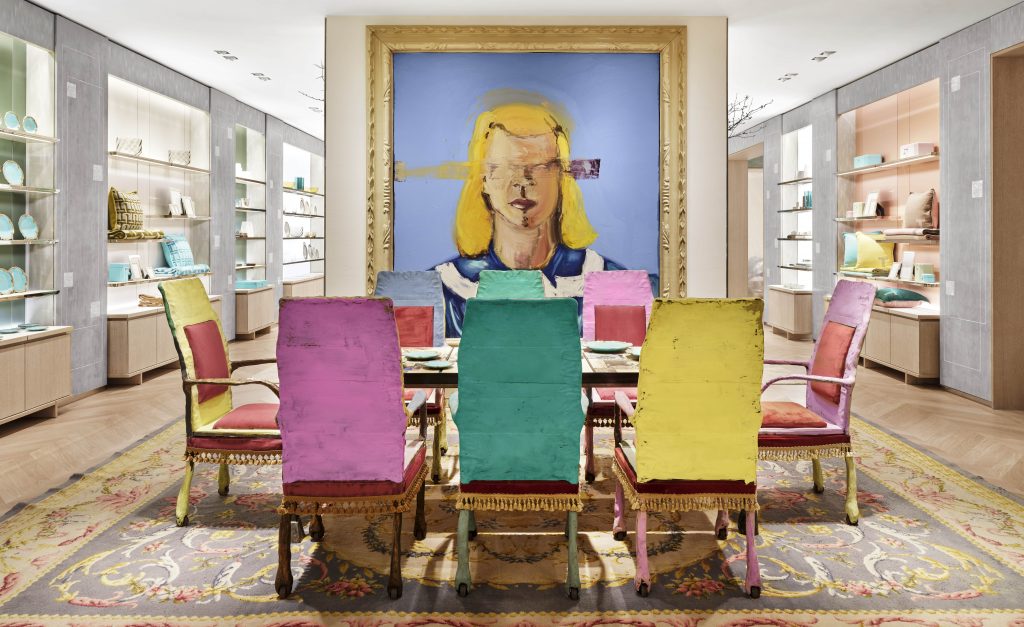
Julian Schnabel’s Girl With No Eyes (2021) and untitled custom painted bronze dinner table (2023) and bronze chairs with rug installation. Courtesy of Tiffany & Co.
“I put them in the private dining room next to the café,” Marino explained. “That’s where they belong. Commercialization and art. It’s very Warholian in its theme. Andy was saying, look, Coca-Cola, Brillo, Heinz Ketchup—that’s what America is all about. It’s about manufacturing, it’s about selling, it’s about commerce. I think Roe is part of that and continuing this Pop Art culture.”
Speaking of Warhol, Marino installed a personal ode to the Pop artist. Silver foil spreads like kudzu on the ceiling above Kapoor’s Random Triangle Mirror. “When I was younger, I went to the Factory and was so impressed with all the aluminum foil at the time,” Marino said. “What was great about the Factory was it became so glamorous, and of course, it was a dollar roll of aluminum foil. You don’t always have to have precious stones. I thought that hipness of what Warhol brought to the world of Pop Art was exactly the kind of shot in the arm that Tiffany needed. At one point I wanted to stick it everywhere. Then I went, no, that’s too retro. I just want it floating on the ceiling like leaves from a tree. And that’s enough. It was my personal gesture to the way I remembered growing up in New York.”

A view of a Richard Prince painting as well as Central Park. Courtesy of Tiffany & Co.
In fact, the Landmark is a series of ongoing personal art gestures for Marino (an entirely different article needs to be written for his furniture journey) as well as evolving group show. “More things are coming. It’s continuing. This work will go on and on and on,” he said. “My office is right down the block and I live two blocks from Tiffany. I was born on 55th Street, and yes, I did press my nose into the glass growing up, just as Holly Golightly did.”
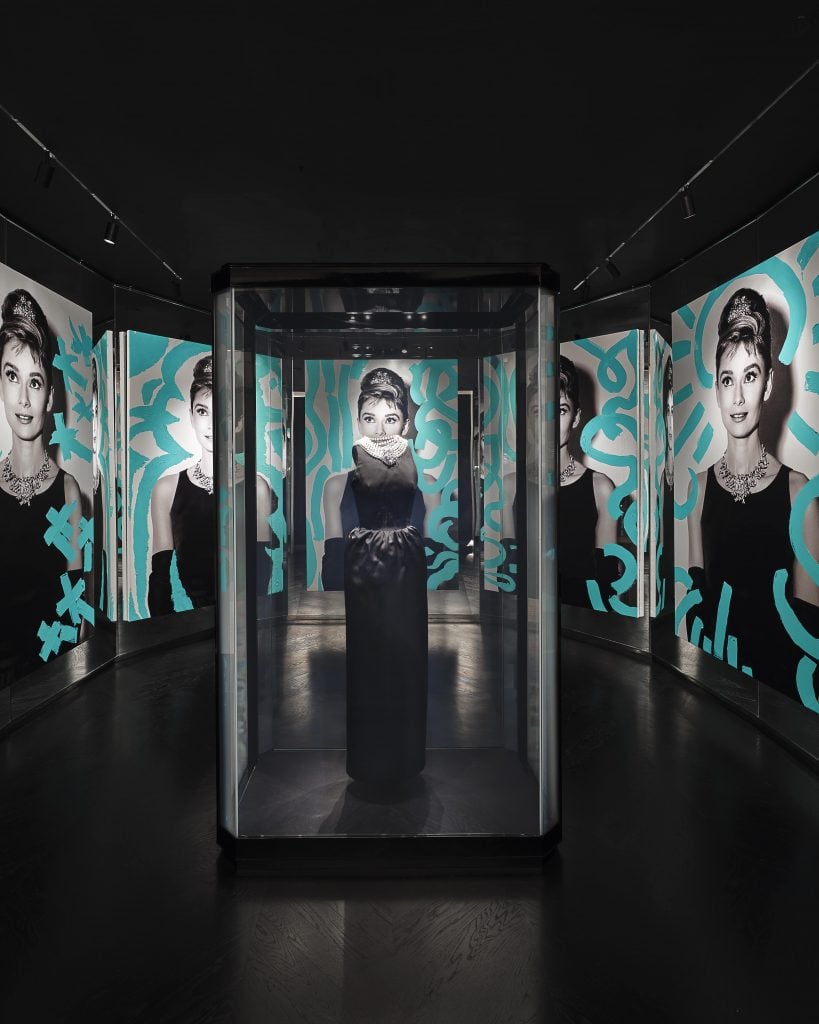
The dedicated Breakfast at Tiffany’s shrine includes multiple portraits of Audrey Hepburn and her iconic Givenchy dress from the film. Courtesy of Tiffany & Co.
Marino began his quest with a trip to the Tiffany archives in New Jersey. “It’s protected by rather fierce Valkyries,” he said. “My whole thesis on doing the store was, Tiffany is the only real true American luxury brand. Who is the Louis Comfort Tiffany of our time? The premier silversmith, jeweler, glassmaker, lamp maker, window maker, skylight maker? Who is that aesthetic genius? I hope I can restore it to its proper place. I was consciously trying to follow in the footsteps of John Loring [Tiffany design director from 1979–2009], who kept bringing modern artists of his time to Tiffany’s, like Warhol and jewelry designers Paloma Picasso and Elsa Peretti. Mine was a very conscious decision to bring some of the best artists and craftsmen of our day forth. I was trying to really go back to the Tiffany of my childhood.”
The feedback has been immediate and gratifying, according to Marino. “The reverberations around the world are absolutely enormous. I’m really happy I rolled up my sleeves and threw myself into it. It was a great opportunity to really make a good work of art.”